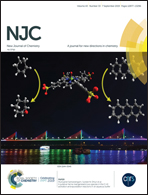Single-crystal X-ray diffraction study, NMR and electrochemical analysis of a copper(i) 5,11,17,23-tetra-tert-butyl-25,26,27,28-tetrakis-[(6-methyl-2,2′-bipyridyl-6-yl)methoxy]calix[4]arene complex: an original M4L2 “hand-to-hand” system†
Abstract
Attempts to prepare a supramolecular M4L2 box involving two tetra-bipyridyl calix[4]arene units and four copper(I) cations afforded, in fact, complex 2 for which, in the solid state, X-ray diffraction analysis showed that the stoichiometry is indeed M4L2, with the two calixarene subunits associated in a “hand-to-hand” mode by complexation via two adjacent bipyridine units to two copper(I) cations, and each group of two residual, adjacent, bipyridine arms is complexed to one copper(I) centre. Mass spectrometry, UV spectroscopy and preliminary 1H-NMR analysis are in preliminary accordance with a monocalixarenic right/left handed M2L structure. Nevertheless, some particularities of the NMR spectrum related to Ar-CH2-Ar and O-CH2bpy resonance signals, the possible generation of the M2L species during the mass spectrometry experiment and the lack of sensitivity of the UV-visible titration caused us to proceed to deeper investigations, looking for other associations, notably the M4L2 “hand-to-hand” systems. This involved 1D and 2D-NMR spectroscopies, among them 1H–15N HMBC, for the reconstruction of the molecule, but also the measurement of self-diffusion coefficients by NMR and electrochemistry. The 2D-NMR analysis and NMR self-diffusion evaluation were in accordance with the M2L structure, but the electrochemical self-diffusion experiment indicated a M4L2 structure.
![Graphical abstract: Single-crystal X-ray diffraction study, NMR and electrochemical analysis of a copper(i) 5,11,17,23-tetra-tert-butyl-25,26,27,28-tetrakis-[(6-methyl-2,2′-bipyridyl-6-yl)methoxy]calix[4]arene complex: an original M4L2 “hand-to-hand” system](/en/Image/Get?imageInfo.ImageType=GA&imageInfo.ImageIdentifier.ManuscriptID=C9NJ01152H&imageInfo.ImageIdentifier.Year=2019)


 Please wait while we load your content...
Please wait while we load your content...